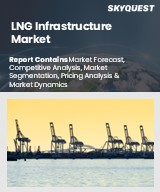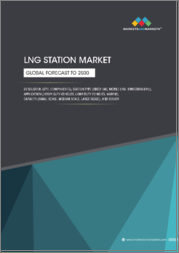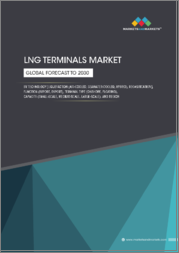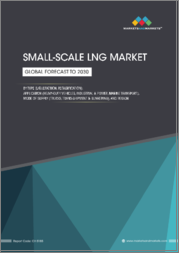
|
시장보고서
상품코드
1365838
세계의 바이오 LNG 시장 : 공급원별, 용도별 - 기회 분석 및 산업 예측(2023-2032년)Bio-LNG Market By Source (Agriculture Residues, Industrial Waste, Household Waste, Others), By Application (Automotive, Ships, Power Generation, Others): Global Opportunity Analysis and Industry Forecast, 2023-2032 |
||||||
바이오 LNG 시장의 2022년 시장 규모는 7억 달러로, 2032년에는 34억 달러에 달할 것으로 추정되며, 2023-2032년의 CAGR은 17.9%로 성장합니다.
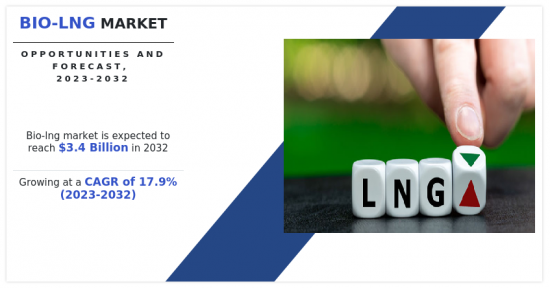
바이오 LNG 시장은 빠르게 성장하고 있습니다. 그 배경에는 기후 변화에 대한 이해가 깊어지고 온실가스 감축이 시급하다는 인식이 자리 잡고 있습니다. 많은 기업, 국가 및 세계 지도자들은 더 깨끗하고 지속가능한 에너지 솔루션을 찾고 있습니다. 현재 인프라에는 광범위하게 보급할 수 있는 대안이 있습니다. 이러한 상황에서 바이오 LNG는 청정 연료로서 큰 잠재력을 가지고 있습니다. 에너지 믹스는 바이오 LNG의 도움으로 크게 다양화될 것으로 예상됩니다. 바이오 LNG의 사용은 화석연료에 대한 의존도를 줄임으로써 국내 및 세계 에너지 안보를 향상시킬 것으로 예상됩니다. 또한 현재 세계 에너지 믹스의 주요 공급원인 석유 및 가스 공급망의 위험과 불안정한 지정학적 리스크에 대한 노출을 줄일 수 있을 것으로 기대됩니다.
바이오 LNG는 현재 운영 중인 기존 LNG 인프라와 천연가스 자동차에 쉽게 통합할 수 있습니다. 바이오 LNG는 현재 에너지 시스템과 호환성이 높기 때문에 기존 인프라를 대대적으로 개조하거나 변경할 필요가 없습니다. 이러한 바이오 LNG의 장점은 바이오 LNG 시장의 성장 촉진요인으로 작용합니다. 그러나 시장은 지속적인 성장을 위해 해결해야 할 과제에 직면해 있습니다. 시장은 유기성 폐기물, 농업 잔류물, 매립지 가스의 불안정하고 신뢰할 수 없는 공급으로 인해 몇 가지 문제에 직면해 있습니다. 원료 수집 및 조달 전략의 최적화가 시장 성장의 잠재력을 가져올 것으로 보입니다.
또한 바이오 LNG의 생산 및 정제 공정은 에너지 집약적이고 비용이 많이 든다는 문제도 있습니다. 전반적인 에너지 효율을 개선하고 생산 비용을 절감하기 위해서는 전체 밸류체인에서 효율적인 기술과 발전이 필수적입니다. 연구개발에 대한 투자는 이러한 장애물을 극복하고 바이오 LNG를 보다 경쟁력 있는 대안으로 만드는 데 중요한 역할을할 것으로 예상됩니다. 정부와 기업이 배출 감소 노력과 지속가능한 운송 솔루션을 우선시함에 따라 바이오 LNG는 시장 성장에 유리한 기회를 제공할 것입니다.
바이오 LNG 시장은 기후 변화에 대한 인식이 높아지고 온실가스 감축에 대한 열망이 높아지면서 괄목할 만한 성장을 보이고 있습니다. 현재 에너지 인프라에 바이오LNG를 통합하는 것은 바이오LNG의 도입을 촉진하고 시장 확대에 박차를 가할 것입니다. 그러나 원료의 가용성, 생산 공정 및 비용에 대한 문제는 전체 바이오 LNG 시장의 성장을 억제하고 있습니다. 바이오 LNG의 몇 가지 환경적 이점과 지속가능한 연료의 기회는 산업 성장에 유리한 성장 기회를 제공할 것으로 예상됩니다.
바이오 LNG 시장은 공급원, 용도, 지역에 따라 조사됩니다. 공급원별로 바이오 LNG 시장은 농업 잔류물, 산업 폐기물, 생활 폐기물 및 기타로 나뉩니다. 농업 잔류물은 농업 또는 작물 잔류물이라고도 합니다. 농업 잔류물은 농업 또는 작물 잔류물이라고도 하며, 농업 활동에서 배출되는 제품별 또는 폐기물입니다. 줄기, 잎, 껍질, 껍질, 껍질, 줄기 등 다양한 식물이 주요 작물을 수확한 후 남은 음식물 찌꺼기에 포함됩니다. 옥수수 줄기, 벼 껍질, 밀짚, 사탕수수 찌꺼기, 사탕수수 바가스 등 농업 폐기물도 바이오 LNG 생산에 사용됩니다. 이러한 폐기물은 산소가 없는 상태에서 미생물이 쓰레기를 분해하는 혐기성 소화를 통해 바이오 LNG로 전환됩니다. 바이오 LNG는 난방, 이동, 발전 등 다양한 용도로 사용할 수 있습니다.
용도별로는 자동차, 선박, 발전, 기타로 나뉩니다. 바이오 LNG(액화천연가스)는 선박, 특히 해운업계에서 보다 깨끗하고 지속가능한 연료로 각광받고 있습니다. 중유(HFO)나 선박용 디젤유(MDO)와 같은 기존 선박용 연료에 비해 몇 가지 장점이 있습니다. 환경적 성능과 배기가스 규제 준수 측면에서 바이오 LNG 연료는 기존 연료보다 월등히 우수합니다. 바이오 LNG와 기존 선박용 연료를 비교하면 온실가스 배출량을 크게 줄일 수 있습니다. 온실가스, 황산화물(SOx), 질소산화물(NOx), 입자 발생이 적어 공기가 좋아지고 환경에 미치는 악영향도 적습니다. 국제해사기구(IMO)는 선박의 황 배출량을 줄이기 위해 엄격한 규제를 시행하고 있습니다. 선박 연료의 황 함량을 제한하는 IMO 2020 황 상한선 규제도 그 중 하나입니다. 선박용 연료의 황 함량을 제한하는 IMO 2020 황 상한선 규제 역시 그러한 법규 중 하나입니다. 바이오 LNG는 황 함량이 거의 없기 때문에 선박 운항자가 이러한 규제에 대응하는 데 도움이 될 수 있습니다. 바이오 LNG는 에너지 밀도가 높아 선박에 기존 LNG와 비슷한 항속거리를 제공합니다. 따라서 선박은 연료 효율을 떨어뜨리지 않고 장거리 항해를 할 수 있습니다.
지역별로는 북미, 유럽, 아시아태평양, 라틴아메리카, 중동 및 아프리카의 바이오 LNG 시장 분석이 이루어지고 있습니다. 미국은 재생에너지 도입에 큰 진전을 보이고 있습니다. 바이오 LNG는 가장 유망한 잠재력 중 하나이기 때문에 미국은 바이오 LNG를 개선하기 위한 연구개발 프로젝트에 많은 자금을 투자하고 있습니다. 정부 외에도 여러 비상장 기업과 조직이 유기성 폐기물과 농업 잔여물을 원료로 하는 바이오 LNG 생산 시설에 투자하고 있습니다. 바이오 LNG는 운송 산업, 특히 대형 운송 및 대중 교통에서 몇 가지 용도가 있습니다. 바이오 LNG는 휘발유와 디젤 연료를 대체할 수 있는 환경 친화적인 연료입니다. 발전 산업에서 저탄소 연료로 바이오 LNG 사용에 대한 관심이 높아짐에 따라 전국적으로 바이오 LNG에 대한 수요가 증가하고 있습니다. 미국 정부는 인센티브, 법률, 규제, 보조금, 재생에너지 구상의 조합을 통해 바이오 LNG 및 기타 재생 연료를 지속적으로 지원하고 있습니다.
- 또한 캐나다는 온실가스 감축과 재생에너지 활성화를 위해 바이오 LNG에 많은 자금을 투자하고 있습니다. 여러 주에서 바이오 LNG 생산 및 인프라 구축을 계획하고 있으며, 특히 유기성 폐기물 원료의 농업 및 임업 부문에 대한 접근이 용이한 지역에서는 계획이 진행되고 있습니다. 바이오 LNG는 운송용 연료로 유망한 대안으로 여겨지기 때문에 정부는 천연가스 공급 인프라가 있는 지역에서 바이오 LNG의 사용을 강조할 계획입니다. 정부는 탄소 배출을 줄이고 청정 에너지 기술을 촉진하기 위한 법과 프로그램을 통해 재생 연료의 사용을 강력하게 지원하고 있습니다.
- 바이오 LNG 산업에서 사업을 도입하는 주요 기업은 Linde plc, Nordsol, Flogas Britain Ltd, EnviTec Biogas AG, Biokraft International AB, TotalEnergies, Titan LNG, DBG Group B.V., BoxLNG Pvt. 각 회사는 시장 점유율을 확대하기 위해 제휴와 같은 주요 전략을 채택했습니다.
- 이 보고서는 시장 성장 촉진요인, 시장 성장 억제요인, 시장 기회를 설명하여 시장 역학에 대한 이해를 돕습니다. 이 보고서는 또한 주요 투자 분야도 강조하고 있습니다. 또한 Portre's Five Forces 분석을 통해 업계의 경쟁 시나리오와 각 이해관계자의 역할을 이해하도록 돕습니다. 이 보고서는 주요 시장 참여 기업이 시장에서 발판을 마련하기 위해 채택한 전략을 소개합니다. 또한 시장 점유율을 확대하고 업계의 치열한 경쟁을 유지하기 위해 주요 기업의 경쟁 구도를 강조하고 있습니다.
목차
제1장 서론
제2장 주요 요약
제3장 시장 개요
- 시장의 정의와 범위
- 주요 조사 결과
- 영향요인
- 주요 투자 기회
- Porter's Five Forces 분석
- 시장 역학
- 촉진요인
- 환경 문제와 재생에너지 정책
- 에너지 안보와 폐기물 관리
- 저배출가스와 기존 인프라와의 호환성
- 억제요인
- 원료 가용성
- 처리와 인프라 비용
- 기술적 과제
- 기회
- 순환경제와 폐기물 관리, 재생에너지로의 이동
- 탈탄소화와 에너지 안보
- 촉진요인
- 밸류체인 분석
- 특허 상황
제4장 바이오 LNG 시장 : 공급원별
- 개요
- 농업 잔류물
- 산업 폐기물
- 가정 폐기물
- 기타
제5장 바이오 LNG 시장 : 용도별
- 개요
- 자동차
- 선박
- 발전
- 기타
제6장 바이오 LNG 시장 : 지역별
- 개요
- 북미
- 미국
- 캐나다
- 멕시코
- 유럽
- 독일
- 영국
- 프랑스
- 이탈리아
- 스페인
- 기타
- 아시아태평양
- 중국
- 일본
- 인도
- 한국
- 호주
- 기타
- 라틴아메리카·중동 및 아프리카
- 브라질
- 사우디아라비아
- 남아프리카공화국
- 기타
제7장 경쟁 구도
- 서론
- 주요 성공 전략
- 주요 10사의 제품 매핑
- 경쟁 대시보드
- 경쟁 히트맵
- 주요 기업의 포지셔닝, 2022년
제8장 기업 개요
- Linde Plc
- Shell Plc.
- Nordsol
- Flogas Britain Ltd.
- EnviTec Biogas AG
- TotalEnergies SE.
- Titan LNG
- BIOKRAFT INTERNATIONAL AB
- DBG Group B.V.
- BoxLNG Pvt. Ltd.
According to a new report published by Allied Market Research, titled, "Bio-LNG Market," The bio-lng market was valued at $0.7 billion in 2022, and is estimated to reach $3.4 billion by 2032, growing at a CAGR of 17.9% from 2023 to 2032.

The market for bio-LNG is expanding quickly. The growing understanding of climate change and the urgent need to cut greenhouse gas emissions is credited with this. Numerous businesses, countries, and world leaders are looking for cleaner, more sustainable energy solutions. The currently existing infrastructure has the preferable alternatives that are simple to deploy on a wide scale. In this situation, bio-LNG has a lot of potential as a clean fuel. The energy mix is expected to be significantly diversified with the help of bio-LNG. The usage of Bio-LNG is anticipated to improve both domestic and global energy security by reducing the dependency on fossil fuels. Moreover, it is also expected to limit the exposure to risks and volatile geopolitics that loom around the oil and gas supply chain that are currently major role players in the world energy mix.
Bio-LNG can be easily integrated into existing LNG infrastructure and natural gas vehicles that are in operation at present. Since bio-LNG is highly compatible with current energy systems Its adoption will not need extensive modifications or changes in existing infrastructure. Such benefits of bio-LNG act as a driving factor for the bio-LNG market growth. However, the market faces challenges that need to be resolved for continuous growth. The market faces several challenges from unstable and unreliable supply of organic waste, agricultural residues, and landfill gas. The optimization of feedstock collection and sourcing strategies will offer the potential for market growth.
Another obstacle to consider is the energy-intensive and costly nature of the bio-LNG production and purification processes. Efficient technologies and advancements in the entire value chain are essential to improve overall energy efficiency and reduce production costs. Investing in R&D is anticipated to play a vital role in overcoming these hurdles and making bio-LNG a more competitive option. Bio-LNG. This offers lucrative opportunities for market growth, as governments and companies prioritize emission reduction efforts and sustainable transportation solutions.
The bio-LNG market has experienced remarkable growth due to heightened climate change awareness and the desire to cut greenhouse gas emissions. Integrating bio-LNG into the current energy infrastructure facilitates its adoption and fuels market expansion. However, challenges related to feedstock availability, production processes, and costs restrain the overall bio-LNG market growth. Several environmental benefits and sustainable fuel opportunities of bio-LNG is expected to offer lucrative growth opportunities for the industry growth.
The bio-LNG market is studied on the basis of source, application, and region. By source, the bio-LNG market is divided into agriculture residues, industrial waste, household waste, and others. Agriculture residues are also known as agricultural or crop residues. They are the by-products or waste materials left from several agricultural activities. A variety of plant materials, including stalks, leaves, husks, shells, and stems, are among the leftovers after the main crop has been harvested. Agricultural wastes like maize stalks, rice husks, wheat straw, sugarcane bagasse, and similar materials are also used in the production of bio-LNG. These wastes are transformed into bio-LNG by anaerobic digestion, which involves microorganisms breaking down trash in the absence of oxygen. It can be utilized for many things, like as heating, moving around, and creating power.
By application, the market is categorized into automotive, ships, power generation, and others. Bio-LNG (liquefied natural gas) is a viable option for cleaner and more sustainable fuel in ships, especially in the maritime industry. It has several benefits against traditional marine fuels, such as heavy fuel oil (HFO) and marine diesel oil (MDO). Regarding environmental performance and compliance with emissions laws, bio-LNG fuel performs significantly better than conventional fuels. When comparing bio-LNG to conventional marine fuels, greenhouse gas emissions can be significantly reduced. The air is better and it has less of an adverse effect on the environment because it creates fewer greenhouse gases, sulfur oxides (SOx), nitrogen oxides (NOx), and particles. The International Maritime Organization (IMO) has created stringent regulations to decrease sulfur emissions from ships. The IMO 2020 sulfur cap, which places a restriction on the sulfur content of marine fuels, is one such law. One such law is the IMO 2020 sulfur cap, which establishes a limit on the sulfur content of marine fuels. Bio-LNG can help ship operators comply with these regulations, as it contains negligible sulfur content. Bio-LNG has a high energy density, providing a similar range to conventional LNG for ships. This allows vessels to cover longer distances without compromising on fuel efficiency.
By region, the bio-LNG market analysis is done across North America, Europe, Asia-Pacific, and LAMEA. The United States has made tremendous progress toward implementing renewable energy sources. The nation is spending a lot of money on research and development projects to improve bio-LNG because it has become one of the most promising possibilities. Apart from the government, several private companies and organizations are investing in bio-LNG production facilities that use organic waste and agricultural residues as feedstock. There are several applications for bio-LNG in the transportation industry, particularly in heavy-duty haulage and public transportation. It offers a more environmentally friendly substitute for gasoline and diesel fuel. The growing interest in using bio-LNG as a low-carbon fuel in the power generation industry has increased demand for bio-LNG throughout the nation. Through a combination of incentives, laws, regulations, subsidies, and renewable energy initiatives, the US government continuously supports bio-LNG and other renewable fuels.
- In addition, Canada is spending a lot of money on bio-LNG in an effort to reduce greenhouse gas emissions and promote renewable energy. Various provinces are planning for bio-LNG production and infrastructure, especially in regions with easy access to agricultural and forestry sectors for organic waste feedstock. The government intends to highlight the use of bio-LNG in areas with natural gas refueling infrastructure since the fuel is thought to be a promising choice for transportation. Through laws and programs meant to cut carbon emissions and boost clean energy technology, the government strongly supports the use of renewable fuels.
- The major players operating in the bio-LNG industry are Linde plc, Nordsol, Flogas Britain Ltd., EnviTec Biogas AG, Biokraft International AB, TotalEnergies, Titan LNG, DBG Group B.V., BoxLNG Pvt. Ltd., and Shell Plc. The companies adopted key strategies such as collaboration to increase their market share.
- The drivers, restraints, and opportunities are explained in the report to better understand the market dynamics. This report further highlights the key areas of investment. In addition, it includes Porter's five forces analysis to understand the competitive scenario of the industry and the role of each stakeholder. The report features strategies adopted by key market players to maintain their foothold in the market. Furthermore, it highlights the competitive landscape of key players to increase their market share and sustain the intense competition in the industry.
Key Benefits For Stakeholders
- This report provides a quantitative analysis of the market segments, current trends, estimations, and dynamics of the bio-lng market analysis from 2022 to 2032 to identify the prevailing bio-lng market opportunities.
- The market research is offered along with information related to key drivers, restraints, and opportunities.
- Porter's five forces analysis highlights the potency of buyers and suppliers to enable stakeholders make profit-oriented business decisions and strengthen their supplier-buyer network.
- In-depth analysis of the bio-lng market segmentation assists to determine the prevailing market opportunities.
- Major countries in each region are mapped according to their revenue contribution to the global market.
- Market player positioning facilitates benchmarking and provides a clear understanding of the present position of the market players.
- The report includes the analysis of the regional as well as global bio-lng market trends, key players, market segments, application areas, and market growth strategies.
Additional benefits you will get with this purchase are:
- Quarterly Update and* (only available with a corporate license, on listed price)
- 5 additional Company Profile of client Choice pre- or Post-purchase, as a free update.
- Free Upcoming Version on the Purchase of Five and Enterprise User License.
- 16 analyst hours of support* (post-purchase, if you find additional data requirements upon review of the report, you may receive support amounting to 16 analyst hours to solve questions, and post-sale queries)
- 15% Free Customization* (in case the scope or segment of the report does not match your requirements, 20% is equivalent to 3 working days of free work, applicable once)
- Free data Pack on the Five and Enterprise User License. (Excel version of the report)
- Free Updated report if the report is 6-12 months old or older.
- 24-hour priority response*
- Free Industry updates and white papers.
Possible Customization with this report (with additional cost and timeline talk to the sales executive to know more)
- Investment Opportunities
- Additional company profiles with specific to client's interest
- Additional country or region analysis- market size and forecast
- Criss-cross segment analysis- market size and forecast
- Expanded list for Company Profiles
- Historic market data
- Import Export Analysis/Data
- List of customers/consumers/raw material suppliers- value chain analysis
- SWOT Analysis
Key Market Segments
By Source
- Agriculture Residues
- Industrial Waste
- Household Waste
- Others
By Application
- Automotive
- Ships
- Power Generation
- Others
By Region
- North America
- U.S.
- Canada
- Mexico
- Europe
- Germany
- UK
- France
- Italy
- Spain
- Rest of Europe
- Asia-Pacific
- China
- Japan
- India
- South Korea
- Australia
- Rest of Asia-Pacific
- LAMEA
- Brazil
- Saudi Arabia
- South Africa
- Rest of LAMEA
Key Market Players:
- Nordsol
- BoxLNG Pvt. Ltd.
- TotalEnergies SE.
- Titan LNG
- EnviTec Biogas AG
- Shell Plc.
- Linde Plc
- DBG Group B.V.
- BIOKRAFT INTERNATIONAL AB
- Flogas Britain Ltd.
TABLE OF CONTENTS
CHAPTER 1: INTRODUCTION
- 1.1. Report description
- 1.2. Key market segments
- 1.3. Key benefits to the stakeholders
- 1.4. Research Methodology
- 1.4.1. Primary research
- 1.4.2. Secondary research
- 1.4.3. Analyst tools and models
CHAPTER 2: EXECUTIVE SUMMARY
- 2.1. CXO Perspective
CHAPTER 3: MARKET OVERVIEW
- 3.1. Market definition and scope
- 3.2. Key findings
- 3.2.1. Top impacting factors
- 3.2.2. Top investment pockets
- 3.3. Porter's five forces analysis
- 3.3.1. Low bargaining power of suppliers
- 3.3.2. Low threat of new entrants
- 3.3.3. Low threat of substitutes
- 3.3.4. Low intensity of rivalry
- 3.3.5. Low bargaining power of buyers
- 3.4. Market dynamics
- 3.4.1. Drivers
- 3.4.1.1. Environment concerns and renewable energy policies
- 3.4.1.2. Energy security and waste management
- 3.4.1.3. Low emissions and compatibility with existing infrastructure
- 3.4.2. Restraints
- 3.4.2.1. Feedstock availability
- 3.4.2.2. Processing and infrastructure costs
- 3.4.2.3. Technological challenges
- 3.4.3. Opportunities
- 3.4.3.1. Circular economy and waste management & renewable energy transition
- 3.4.3.2. Decarbonization and energy security
- 3.4.1. Drivers
- 3.5. Value Chain Analysis
- 3.6. Patent Landscape
CHAPTER 4: BIO-LNG MARKET, BY SOURCE
- 4.1. Overview
- 4.1.1. Market size and forecast
- 4.2. Agriculture Residues
- 4.2.1. Key market trends, growth factors and opportunities
- 4.2.2. Market size and forecast, by region
- 4.2.3. Market share analysis by country
- 4.3. Industrial Waste
- 4.3.1. Key market trends, growth factors and opportunities
- 4.3.2. Market size and forecast, by region
- 4.3.3. Market share analysis by country
- 4.4. Household Waste
- 4.4.1. Key market trends, growth factors and opportunities
- 4.4.2. Market size and forecast, by region
- 4.4.3. Market share analysis by country
- 4.5. Others
- 4.5.1. Key market trends, growth factors and opportunities
- 4.5.2. Market size and forecast, by region
- 4.5.3. Market share analysis by country
CHAPTER 5: BIO-LNG MARKET, BY APPLICATION
- 5.1. Overview
- 5.1.1. Market size and forecast
- 5.2. Automotive
- 5.2.1. Key market trends, growth factors and opportunities
- 5.2.2. Market size and forecast, by region
- 5.2.3. Market share analysis by country
- 5.3. Ships
- 5.3.1. Key market trends, growth factors and opportunities
- 5.3.2. Market size and forecast, by region
- 5.3.3. Market share analysis by country
- 5.4. Power Generation
- 5.4.1. Key market trends, growth factors and opportunities
- 5.4.2. Market size and forecast, by region
- 5.4.3. Market share analysis by country
- 5.5. Others
- 5.5.1. Key market trends, growth factors and opportunities
- 5.5.2. Market size and forecast, by region
- 5.5.3. Market share analysis by country
CHAPTER 6: BIO-LNG MARKET, BY REGION
- 6.1. Overview
- 6.1.1. Market size and forecast By Region
- 6.2. North America
- 6.2.1. Key market trends, growth factors and opportunities
- 6.2.2. Market size and forecast, by Source
- 6.2.3. Market size and forecast, by Application
- 6.2.4. Market size and forecast, by country
- 6.2.4.1. U.S.
- 6.2.4.1.1. Market size and forecast, by Source
- 6.2.4.1.2. Market size and forecast, by Application
- 6.2.4.2. Canada
- 6.2.4.2.1. Market size and forecast, by Source
- 6.2.4.2.2. Market size and forecast, by Application
- 6.2.4.3. Mexico
- 6.2.4.3.1. Market size and forecast, by Source
- 6.2.4.3.2. Market size and forecast, by Application
- 6.3. Europe
- 6.3.1. Key market trends, growth factors and opportunities
- 6.3.2. Market size and forecast, by Source
- 6.3.3. Market size and forecast, by Application
- 6.3.4. Market size and forecast, by country
- 6.3.4.1. Germany
- 6.3.4.1.1. Market size and forecast, by Source
- 6.3.4.1.2. Market size and forecast, by Application
- 6.3.4.2. UK
- 6.3.4.2.1. Market size and forecast, by Source
- 6.3.4.2.2. Market size and forecast, by Application
- 6.3.4.3. France
- 6.3.4.3.1. Market size and forecast, by Source
- 6.3.4.3.2. Market size and forecast, by Application
- 6.3.4.4. Italy
- 6.3.4.4.1. Market size and forecast, by Source
- 6.3.4.4.2. Market size and forecast, by Application
- 6.3.4.5. Spain
- 6.3.4.5.1. Market size and forecast, by Source
- 6.3.4.5.2. Market size and forecast, by Application
- 6.3.4.6. Rest of Europe
- 6.3.4.6.1. Market size and forecast, by Source
- 6.3.4.6.2. Market size and forecast, by Application
- 6.4. Asia-Pacific
- 6.4.1. Key market trends, growth factors and opportunities
- 6.4.2. Market size and forecast, by Source
- 6.4.3. Market size and forecast, by Application
- 6.4.4. Market size and forecast, by country
- 6.4.4.1. China
- 6.4.4.1.1. Market size and forecast, by Source
- 6.4.4.1.2. Market size and forecast, by Application
- 6.4.4.2. Japan
- 6.4.4.2.1. Market size and forecast, by Source
- 6.4.4.2.2. Market size and forecast, by Application
- 6.4.4.3. India
- 6.4.4.3.1. Market size and forecast, by Source
- 6.4.4.3.2. Market size and forecast, by Application
- 6.4.4.4. South Korea
- 6.4.4.4.1. Market size and forecast, by Source
- 6.4.4.4.2. Market size and forecast, by Application
- 6.4.4.5. Australia
- 6.4.4.5.1. Market size and forecast, by Source
- 6.4.4.5.2. Market size and forecast, by Application
- 6.4.4.6. Rest of Asia-Pacific
- 6.4.4.6.1. Market size and forecast, by Source
- 6.4.4.6.2. Market size and forecast, by Application
- 6.5. LAMEA
- 6.5.1. Key market trends, growth factors and opportunities
- 6.5.2. Market size and forecast, by Source
- 6.5.3. Market size and forecast, by Application
- 6.5.4. Market size and forecast, by country
- 6.5.4.1. Brazil
- 6.5.4.1.1. Market size and forecast, by Source
- 6.5.4.1.2. Market size and forecast, by Application
- 6.5.4.2. Saudi Arabia
- 6.5.4.2.1. Market size and forecast, by Source
- 6.5.4.2.2. Market size and forecast, by Application
- 6.5.4.3. South Africa
- 6.5.4.3.1. Market size and forecast, by Source
- 6.5.4.3.2. Market size and forecast, by Application
- 6.5.4.4. Rest of LAMEA
- 6.5.4.4.1. Market size and forecast, by Source
- 6.5.4.4.2. Market size and forecast, by Application
CHAPTER 7: COMPETITIVE LANDSCAPE
- 7.1. Introduction
- 7.2. Top winning strategies
- 7.3. Product Mapping of Top 10 Player
- 7.4. Competitive Dashboard
- 7.5. Competitive Heatmap
- 7.6. Top player positioning, 2022
CHAPTER 8: COMPANY PROFILES
- 8.1. Linde Plc
- 8.1.1. Company overview
- 8.1.2. Key Executives
- 8.1.3. Company snapshot
- 8.1.4. Operating business segments
- 8.1.5. Product portfolio
- 8.1.6. Business performance
- 8.1.7. Key strategic moves and developments
- 8.2. Shell Plc.
- 8.2.1. Company overview
- 8.2.2. Key Executives
- 8.2.3. Company snapshot
- 8.2.4. Operating business segments
- 8.2.5. Product portfolio
- 8.2.6. Business performance
- 8.2.7. Key strategic moves and developments
- 8.3. Nordsol
- 8.3.1. Company overview
- 8.3.2. Key Executives
- 8.3.3. Company snapshot
- 8.3.4. Operating business segments
- 8.3.5. Product portfolio
- 8.3.6. Key strategic moves and developments
- 8.4. Flogas Britain Ltd.
- 8.4.1. Company overview
- 8.4.2. Key Executives
- 8.4.3. Company snapshot
- 8.4.4. Operating business segments
- 8.4.5. Product portfolio
- 8.5. EnviTec Biogas AG
- 8.5.1. Company overview
- 8.5.2. Key Executives
- 8.5.3. Company snapshot
- 8.5.4. Operating business segments
- 8.5.5. Product portfolio
- 8.5.6. Business performance
- 8.6. TotalEnergies SE.
- 8.6.1. Company overview
- 8.6.2. Key Executives
- 8.6.3. Company snapshot
- 8.6.4. Operating business segments
- 8.6.5. Product portfolio
- 8.6.6. Business performance
- 8.6.7. Key strategic moves and developments
- 8.7. Titan LNG
- 8.7.1. Company overview
- 8.7.2. Key Executives
- 8.7.3. Company snapshot
- 8.7.4. Operating business segments
- 8.7.5. Product portfolio
- 8.8. BIOKRAFT INTERNATIONAL AB
- 8.8.1. Company overview
- 8.8.2. Key Executives
- 8.8.3. Company snapshot
- 8.8.4. Operating business segments
- 8.8.5. Product portfolio
- 8.8.6. Business performance
- 8.8.7. Key strategic moves and developments
- 8.9. DBG Group B.V.
- 8.9.1. Company overview
- 8.9.2. Key Executives
- 8.9.3. Company snapshot
- 8.9.4. Operating business segments
- 8.9.5. Product portfolio
- 8.9.6. Key strategic moves and developments
- 8.10. BoxLNG Pvt. Ltd.
- 8.10.1. Company overview
- 8.10.2. Key Executives
- 8.10.3. Company snapshot
- 8.10.4. Operating business segments
- 8.10.5. Product portfolio
- 8.10.6. Key strategic moves and developments






